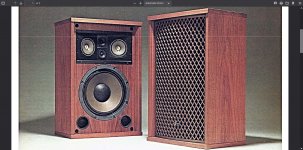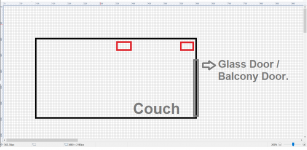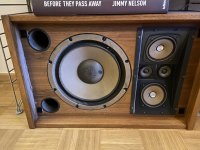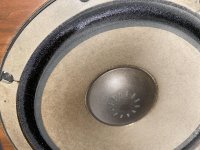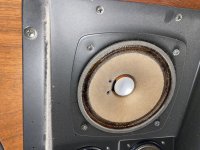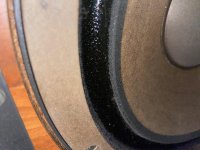Hello everyone!
This is my first post on this forum and my first true DIY audio project (other than soldering and de-soldering stuff). so my expertise may not match my ambitions, please stop me in my tracks when you think what i'm trying to do might be too much.
I'm trying to 're purpose' (or honestly re-design) a pair of speakers from the 70s using the knowledge that we have today to better fit my room. The speakers are Sansui SP1700 (pic below)

I want to keep the enclosure (plus the dust/air filter) because my boyfriend is very much attached to these speakers (i mean they look gorgeous too) because his grandparents gave them to him when the moved to a smaller house. I've tried so much to convince him to no avail so this is what i can work with.
Brochure: https://www.vintageshifi.com/repert...pRLPMzQbXiBv_X3e59IVjJyIoChwq3dIAkf_OKoialOJM
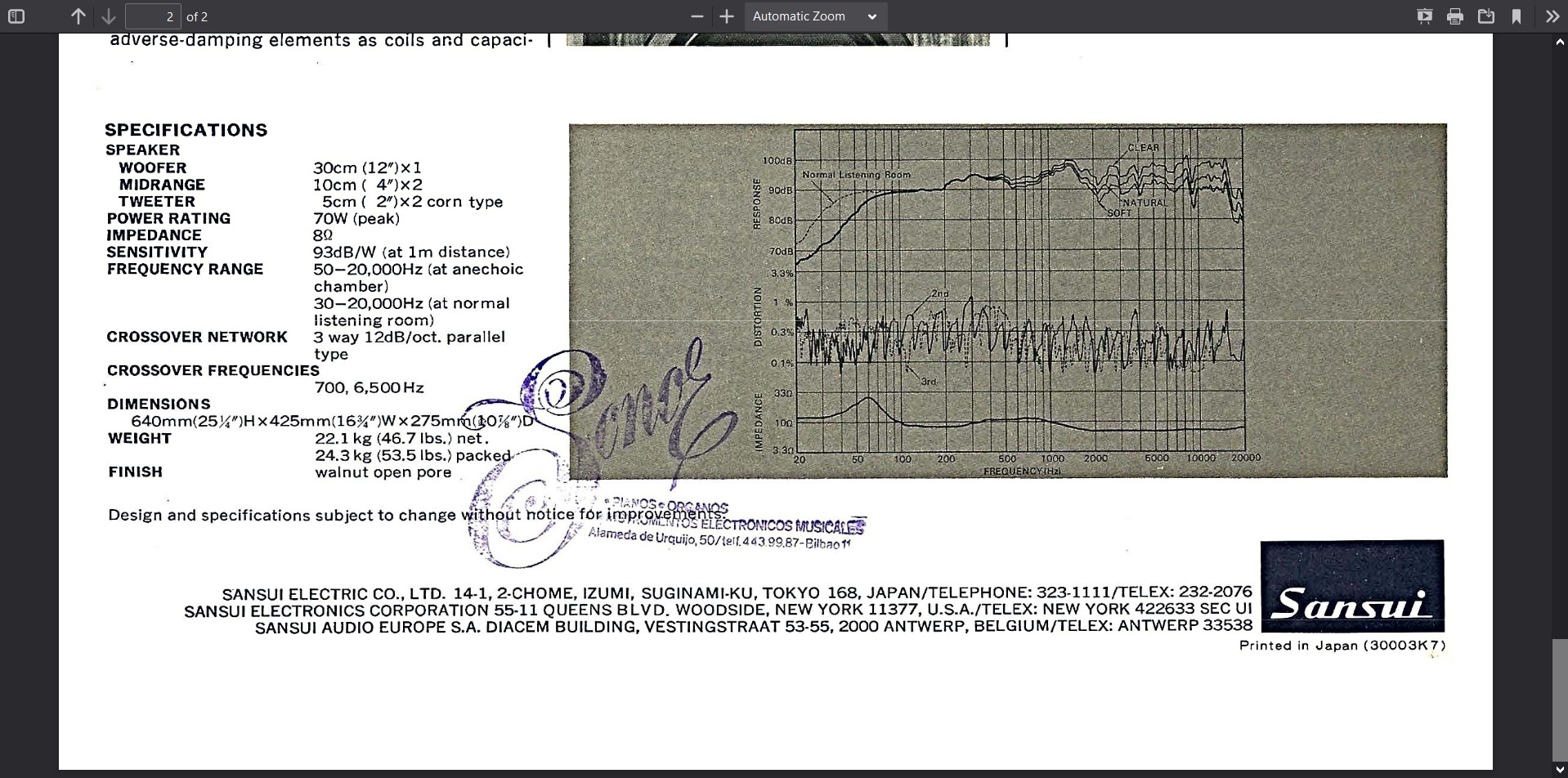
This is the room configuration (non-negotiable too )
)

My goals:
1) Pump my speakers, i want them to look from the outside exactly the same way (oak enclosure, air/dust filter) while from the inside the inner cabinets could be completely rebuilt from scratch.
2) redesign the enclosures in a way that the speaker responds better to placing it a) horizontally b) on the ground.
3) remove one of the tweeters to avoid the comb effect.
Things that i dislike / would rather not do:
1) Active crossover, i don't have a multichannel Amplifier so unless it is absolutely necessary i rather not do that.
2) TOO much EQ, I also use these as speakers for my TV, so i would rather the sound to be 'OKAY' without EQ. but i don't have a problem with the concept itself.
Please direct me to all the resources that can help me in this endavor, I'm super pumped and i really would like to turn these beauties into a complete work of art. Thank you for your help!
This is my first post on this forum and my first true DIY audio project (other than soldering and de-soldering stuff). so my expertise may not match my ambitions, please stop me in my tracks when you think what i'm trying to do might be too much.
I'm trying to 're purpose' (or honestly re-design) a pair of speakers from the 70s using the knowledge that we have today to better fit my room. The speakers are Sansui SP1700 (pic below)
I want to keep the enclosure (plus the dust/air filter) because my boyfriend is very much attached to these speakers (i mean they look gorgeous too) because his grandparents gave them to him when the moved to a smaller house. I've tried so much to convince him to no avail so this is what i can work with.
Brochure: https://www.vintageshifi.com/repert...pRLPMzQbXiBv_X3e59IVjJyIoChwq3dIAkf_OKoialOJM
This is the room configuration (non-negotiable too
 )
)My goals:
1) Pump my speakers, i want them to look from the outside exactly the same way (oak enclosure, air/dust filter) while from the inside the inner cabinets could be completely rebuilt from scratch.
2) redesign the enclosures in a way that the speaker responds better to placing it a) horizontally b) on the ground.
3) remove one of the tweeters to avoid the comb effect.
Things that i dislike / would rather not do:
1) Active crossover, i don't have a multichannel Amplifier so unless it is absolutely necessary i rather not do that.
2) TOO much EQ, I also use these as speakers for my TV, so i would rather the sound to be 'OKAY' without EQ. but i don't have a problem with the concept itself.
Please direct me to all the resources that can help me in this endavor, I'm super pumped and i really would like to turn these beauties into a complete work of art. Thank you for your help!
Attachments
Last edited:
Personally, I'd leave them alone, and build something from scratch, or from a kit.
Oh, and welcome to the forum.🙂
jeff
Oh, and welcome to the forum.🙂
jeff
Very nice piece of furniture. How about its sound, do you like it or not in general? There are different levels of vintage loudspeaker renovation.
To start with you can just to check if speaker units have good elastic surrounds which seems not highly probable for their 50+ age.
To start with you can just to check if speaker units have good elastic surrounds which seems not highly probable for their 50+ age.
Personally, I'd leave them alone, and build something from scratch, or from a kit.
Oh, and welcome to the forum.🙂
jeff
I wanted to build the LXmini by Linkwitz but it’s a fool’s errand to convince him of giving these away or selling them.
Very nice piece of furniture. How about its sound, do you like it or not in general? There are different levels of vintage loudspeaker renovation.
To start with you can just to check if speaker units have good elastic surrounds which seems not highly probable for their 50+ age.
How do you test the elastic surrounds? I mean there is nothing deeply problematic about their sound, it’s just meh.
Very lightly press the cone in a couple of mm. Even distribution of force on the periphery, or at least ensuring no offset load. How does it move under that (light, and please don't do this with the tweeters) pressure, and does it spring back nicely when released? If so, surrounds should be OK.
The Sansui speakers weren't the greatest, but they're classics of their '70s type so if they're in good shape & your boyfriend is as attached to them as you say, then I'd frankly leave them well alone rather than risk screwing them up. You could have a look at the crossover, check the components. If there are any bipolar electrolytic caps in there, they're probably on the way out or shot by now, so either replace like-for-like, or check the spec. of the originals, replace with film caps, and if necessary add some series R. If it's using bipolar electrolytics the XO may have been designed accounting for the ESR of the original caps (when new), and film caps typically are much lower, so some additional series resistance might be necessary to bring things into line. However, it's often found simply replacing aged electrolytics like-for-like effects an immediate improvement.
The Sansui speakers weren't the greatest, but they're classics of their '70s type so if they're in good shape & your boyfriend is as attached to them as you say, then I'd frankly leave them well alone rather than risk screwing them up. You could have a look at the crossover, check the components. If there are any bipolar electrolytic caps in there, they're probably on the way out or shot by now, so either replace like-for-like, or check the spec. of the originals, replace with film caps, and if necessary add some series R. If it's using bipolar electrolytics the XO may have been designed accounting for the ESR of the original caps (when new), and film caps typically are much lower, so some additional series resistance might be necessary to bring things into line. However, it's often found simply replacing aged electrolytics like-for-like effects an immediate improvement.
If you were going to do a complete redesign I'd be inclined to go with a three way and use a coaxial driver for the midrange/treble. That way you can orientate the speakers whichever way you want, without messing up driver layout geometries relative to the listener, and you can listen at different heights. Mid/tweeter integration will then remain the same regardless of where you sit and position the speakers. Added bonus is the waveguide loading, that the midrange cone provides for the tweeter, evens out the off axis treble meaning the sound is more consistent as you go off axis.
Plus if you mounted the coaxial driver to the side at the top of the cabinets you make them into mirror image pairs. Like this. Imagine the coax where the tweeter is.

Then if you rotate the cabinets so that they are on their sides the coax will still be elevated off the floor, as high as it can go, in both orientations. Upright or on their side.
As an idea for the entire finished speaker I'm thinking something along the lines of this...
SEAS KingRO4Y Mk III
Not that as per say but similar in concept.
Alternatively, as you said you had ideas about the LXmini, go with a two way using a 10-12" bass driver and a Scanspeak 10F full range. Something along the lines of this.
10F/8424 & RS225-8 FAST / WAW Ref Monitor
For the coaxial idea I would probably go with this...
H1699-08/06 MR18REX/XF
I'd either reuse the Sansui driver or use this as a bass replacement.
12″ SB34NRXL75-8 / Norex – Sbacoustics
Of which you can see measurements here.
SB Acoustics SB34NRXL75-8 | HiFiCompass
You'd have to make new baffles I'd imagine and maybe go with a 10" bass driver if things wouldn't fit.
It depends how complicated you want these to be in terms of woodwork and in terms of crossover design.
Plus if you mounted the coaxial driver to the side at the top of the cabinets you make them into mirror image pairs. Like this. Imagine the coax where the tweeter is.
Then if you rotate the cabinets so that they are on their sides the coax will still be elevated off the floor, as high as it can go, in both orientations. Upright or on their side.
As an idea for the entire finished speaker I'm thinking something along the lines of this...
SEAS KingRO4Y Mk III
Not that as per say but similar in concept.
Alternatively, as you said you had ideas about the LXmini, go with a two way using a 10-12" bass driver and a Scanspeak 10F full range. Something along the lines of this.
10F/8424 & RS225-8 FAST / WAW Ref Monitor
For the coaxial idea I would probably go with this...
H1699-08/06 MR18REX/XF
I'd either reuse the Sansui driver or use this as a bass replacement.
12″ SB34NRXL75-8 / Norex – Sbacoustics
Of which you can see measurements here.
SB Acoustics SB34NRXL75-8 | HiFiCompass
You'd have to make new baffles I'd imagine and maybe go with a 10" bass driver if things wouldn't fit.
It depends how complicated you want these to be in terms of woodwork and in terms of crossover design.
Attachments
Just replace old bipolar electrolytic condensers in the crossover with the new one (with the same capacitance) and enjoy!
^^^^^^^^ that.
IF you will start replacing speakers and crossovers, you might as well build a new one, so just update those old dry capacitors with exact same value but modern versions and, as said above, enjoy.
IF treated cloth edge, it might still be fine.
Or it plus cone suspension/"spider" might have become stiff, it´s 50 years old!
But if it was used more or less regularly,"exercise" might have kept it in good shape.
Apparently from what you say, they are fine, so don´t mess with it.
IF you will start replacing speakers and crossovers, you might as well build a new one, so just update those old dry capacitors with exact same value but modern versions and, as said above, enjoy.
Not clear from your pictures and not mentioned in brochure but IF they are foam edged, foam self destroys by oxydation and UV, cracking or becoming a gummy mess, easy to see.How do you test the elastic surrounds? I mean there is nothing deeply problematic about their sound, it’s just meh.
IF treated cloth edge, it might still be fine.
Or it plus cone suspension/"spider" might have become stiff, it´s 50 years old!
But if it was used more or less regularly,"exercise" might have kept it in good shape.
Apparently from what you say, they are fine, so don´t mess with it.
Abdo,This is the room configuration (non-negotiable too)
1) Pump my speakers, i want them to look from the outside exactly the same way (oak enclosure, air/dust filter) while from the inside the inner cabinets could be completely rebuilt from scratch.
2) redesign the enclosures in a way that the speaker responds better to placing it a) horizontally b) on the ground.
3) remove one of the tweeters to avoid the comb effect.
Things that i dislike / would rather not do:
1) Active crossover, i don't have a multichannel Amplifier so unless it is absolutely necessary i rather not do that.
2) TOO much EQ, I also use these as speakers for my TV, so i would rather the sound to be 'OKAY' without EQ. but i don't have a problem with the concept itself.
Around 2010 acquired a pair of Sansui speakers that were probably just slightly older than yours. They had almost the same speaker and crossover compliment, though all the drivers were front mounted and the Kumiko grill was not curved.
Even though they had been in the high, dry, desert for years, and were probably purchased by a US soldier via PX, (post exchange) during the Vietnam War, all the drivers and crossover components still worked "as new", and probably still do, they still worked fine in 2016 when I sold them.
Your non-negotiable, off center on the long wall placement of the speakers to some extent renders any improvements a moot point, but I won't try to convince you any further of that 🙂.
1) Unless you are looking for louder or lower response than the drivers can provide, no need to "pump them up".
2) Horizontal placement on the ground is bad for stereo imaging, but if you are set on that option, there are some options.
3) The speakers are voiced quite "hot" in the mid-high range, so bypassing one of the mid and high drivers would be OK. Rather than removing them, unwire them from the crossover, and put a shorting wire across the unused terminals.
Wire resistors of the nominal speaker impedance (IIRC, they may be an "odd" value like 12 ohms) to the wires that formerly went to the bypassed drivers.
This should bring the mid-high response down around 6 dB, and eliminate some of the comb filtering.
Since the speakers are horizontilly floor mounted, you will want to mirror image the cabinets with the mid-high placed center, the lower, up-firing mid connected, and the inward pointing tweeter connected.
The range around 700 Hz may still be a bit "hot" even with the attenuation switch set to "soft", the woofer may be responsible for most of that. That peak could probably be tamed with some felt placed in front of the 12" cone on the inside of the grille. A passive notch filter could be used, but would require impedance testing and acoustical measurement to design it.
With the simple changes listed above, little EQ needed to the correct the speaker's response will be needed, they should sound 'OKAY'.
Good Luck!
Art
rebuild the crossover and test until good.
I am just finishing doing that to 1981 Pioneer HPM 900's I also did not want to part with.
They are now superb.
woofer ( 500 to 1500hz)
Tweeters ( 4K to 8k)
adjust mids as required to fill in gap
I am just finishing doing that to 1981 Pioneer HPM 900's I also did not want to part with.
They are now superb.
woofer ( 500 to 1500hz)
Tweeters ( 4K to 8k)
adjust mids as required to fill in gap
Last edited:
In post #10, meant to write the peak at 1500 Hz, above the nominal 700Hz crossover, may be due to the woofer, which is directly connected to the input with no coils or capacitors.The range around 700 Hz may still be a bit "hot" even with the attenuation switch set to "soft", the woofer may be responsible for most of that.
I would be extremely careful about doing anything to your boyfriends nostalgic inheritance from his grandparents.
This is your first project.
The risk is too high breaking this speaker.
Start something from scratch instead it’s easy to assemble similar looking woodwork like this and there is no risk in doing so.
A Eminence Beta 12”CX and a Compression Driver works great in this kind of box design. Simple two way, made in a week. 30x40x60cm inner = 70l bassreflex.
This is your first project.
The risk is too high breaking this speaker.
Start something from scratch instead it’s easy to assemble similar looking woodwork like this and there is no risk in doing so.
A Eminence Beta 12”CX and a Compression Driver works great in this kind of box design. Simple two way, made in a week. 30x40x60cm inner = 70l bassreflex.
I agree with those who suggest you be careful and to not think about hot rodding these.
New caps are probably a good idea but check them first.
Don’t worry about the tweeter combing, they are vertically aligned. The mids might be a concern but they looked to be toed in so they may not be much of a problem.
Good that you want to get involved. What boyfriend wouldn’t like that?
If you want to pimp something, go to your local good will store and see if you can find some decent boxes with worn out drivers and start researching what will work. I am going to venture that most everyone here has done it and it sure beats messing with a family heirloom.
Good luck with it.
New caps are probably a good idea but check them first.
Don’t worry about the tweeter combing, they are vertically aligned. The mids might be a concern but they looked to be toed in so they may not be much of a problem.
Good that you want to get involved. What boyfriend wouldn’t like that?
If you want to pimp something, go to your local good will store and see if you can find some decent boxes with worn out drivers and start researching what will work. I am going to venture that most everyone here has done it and it sure beats messing with a family heirloom.
Good luck with it.
Im not sure the OP is a boy or girl but in any case to me if my better half messed with my assets without clarifying fully with me first I’d be pissed. I believe from what I read the BF doesn’t want these speakers to be messed with. This is a potential huge fight and possibly a breakup reason given the history of the speakers. Hifi in general is one thing don’t mess with a mans hifi. Old hifi even more. Something inherited in family even more sensitive could be a disaster. Be careful here.Good that you want to get involved. What boyfriend wouldn’t like that?
Last edited:
EDIT: I now see you want to lay them on their side so yes the comb filtering might be a concern with the tweeters but that will mean adding a resistor in place of the voice coil to keep the xo doing it's job.
And yes, those are wise words from fabricadetabaco.
And yes, those are wise words from fabricadetabaco.
Hey guys thank you for all your comments!
I already recapped them like a month ago, night and day difference.
In the attachments are pictures of the elastic surrounds, they look really gleamy, as if they're dipped in Tar. they're not disintegrating and they're still somewhat elastic (bounce back when lightly pushed with fingers).
Do you recommend that i replace the elastic surrounds?
Oh no i'm fully upfront with my better half, they're his speakers after all.
I'm not going to do something i'm not 99% sure i can pull off, this is all in the 'planning' stage.
But honestly it feels like other than some renovating work here and there there is not much i can do.
I already recapped them like a month ago, night and day difference.
In the attachments are pictures of the elastic surrounds, they look really gleamy, as if they're dipped in Tar. they're not disintegrating and they're still somewhat elastic (bounce back when lightly pushed with fingers).
Do you recommend that i replace the elastic surrounds?
Im not sure the OP is a boy or girl but in any case to me if my better half messed with my assets without clarifying fully with me first I’d be pissed. I believe from what I read the BF doesn’t want these speakers to be messed with. This is a potential huge fight and possibly a breakup reason given the history of the speakers. Hifi in general is one thing don’t mess with a mans hifi. Old hifi even more. Something inherited in family even more sensitive could be a disaster. Be careful here.
Oh no i'm fully upfront with my better half, they're his speakers after all.
I'm not going to do something i'm not 99% sure i can pull off, this is all in the 'planning' stage.
But honestly it feels like other than some renovating work here and there there is not much i can do.
Attachments
To me these would seem fairly straightforward to modify.
The midrange/tweeter unit looks like it would lift right out if you unscrewed it. This would allow you to make a new module that would slot right in. It looks like its recessed along the sides. A flat piece of timber of the same dimensions, with matching screw holes would work to cover the old hole then some strips of a weather sealing foam, meant for doors, would make light work of the recess.
You could then do whatever you wanted with a new mid/tweeter design, so long as the drivers would fit. Again a coaxial would take less space. The advantage being that this doesn't affect the old cabinet in anyway and is 100% reverseable.
If you wanted to go for a new woofer too I would advise a similar approach. Cut out a circle of timber the exact same size as the old woofer, so that the circle will fit into the recess where the 12" now sits. Screw that into the cabinet using the old screw holes. You can then reinforce the backside of the timber circle if it's too thin for rigidity. Like cut a circle of 18mm MDF out the diameter of the hole that the 12" driver fits though and stick it to the back of the timber circle.
Then all you need is a new driver that you can mount on the timber circle you've made. It will have to be smaller, probably a 10", but there are loads of those that would fit. You might have to seal the old ports. Again this would be reverseable too and require no modification of the original cabinet. Unless you can find a new 12" that fits the old recess. Do you have the exact diameter of the bass driver?
I've done the above methods myself once or twice, to put new drivers in old cabinets, and it works very well.
How do you find the bass of the original speakers anyway? The surrounds are basically cloth doped in something to seal the gaps in the weave but something that doesn't completely set. A bit like how soft dome tweeters are made. Years ago the doping material used to leave the tweeter sticky and would attract dust. The surrounds here look fairly dust free.
The midrange/tweeter unit looks like it would lift right out if you unscrewed it. This would allow you to make a new module that would slot right in. It looks like its recessed along the sides. A flat piece of timber of the same dimensions, with matching screw holes would work to cover the old hole then some strips of a weather sealing foam, meant for doors, would make light work of the recess.
You could then do whatever you wanted with a new mid/tweeter design, so long as the drivers would fit. Again a coaxial would take less space. The advantage being that this doesn't affect the old cabinet in anyway and is 100% reverseable.
If you wanted to go for a new woofer too I would advise a similar approach. Cut out a circle of timber the exact same size as the old woofer, so that the circle will fit into the recess where the 12" now sits. Screw that into the cabinet using the old screw holes. You can then reinforce the backside of the timber circle if it's too thin for rigidity. Like cut a circle of 18mm MDF out the diameter of the hole that the 12" driver fits though and stick it to the back of the timber circle.
Then all you need is a new driver that you can mount on the timber circle you've made. It will have to be smaller, probably a 10", but there are loads of those that would fit. You might have to seal the old ports. Again this would be reverseable too and require no modification of the original cabinet. Unless you can find a new 12" that fits the old recess. Do you have the exact diameter of the bass driver?
I've done the above methods myself once or twice, to put new drivers in old cabinets, and it works very well.
How do you find the bass of the original speakers anyway? The surrounds are basically cloth doped in something to seal the gaps in the weave but something that doesn't completely set. A bit like how soft dome tweeters are made. Years ago the doping material used to leave the tweeter sticky and would attract dust. The surrounds here look fairly dust free.
The bass is the highpoint of these speakers, it's excellent. in fact, it's too excellent that I had to do an EQ (200Hz and below) to get its amplitude some where similar to the rest of the frequency curve.
This is the frequency response curve at 75db target, -12dbfs. it could honestly be my room placement but i really think they need help.


This is the frequency response curve at 75db target, -12dbfs. it could honestly be my room placement but i really think they need help.
Attachments
Last edited:
Not a lot you can do about room modes unfortunately. Well except multiple subs and DSP EQ.
If the speakers were designed to be placed on short stands it makes sense that you'd have to apply a small amount of cut below around 200Hz to balance the sound. Placed on the floor you will get a reduction in the amount of bafflestep compensation the speaker will generally need.
If the bass of these is excellent then that simplifies modification. Just make a new panel to replace the old mid/tweeter one and stuff it with new drivers.
If the speakers were designed to be placed on short stands it makes sense that you'd have to apply a small amount of cut below around 200Hz to balance the sound. Placed on the floor you will get a reduction in the amount of bafflestep compensation the speaker will generally need.
If the bass of these is excellent then that simplifies modification. Just make a new panel to replace the old mid/tweeter one and stuff it with new drivers.
- Home
- Loudspeakers
- Multi-Way
- Re-designing Speakers from the 70s (Sansui SP 1700)
